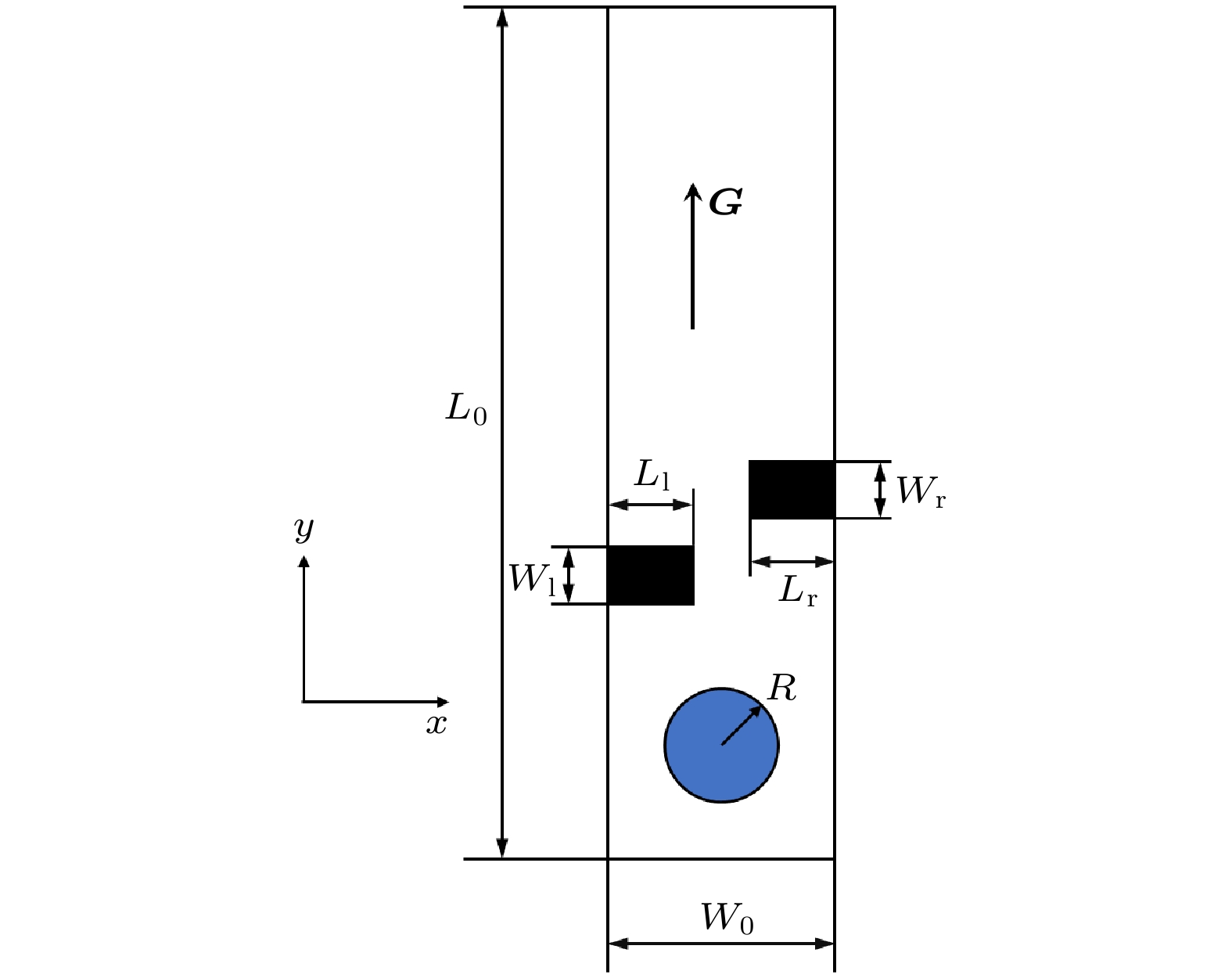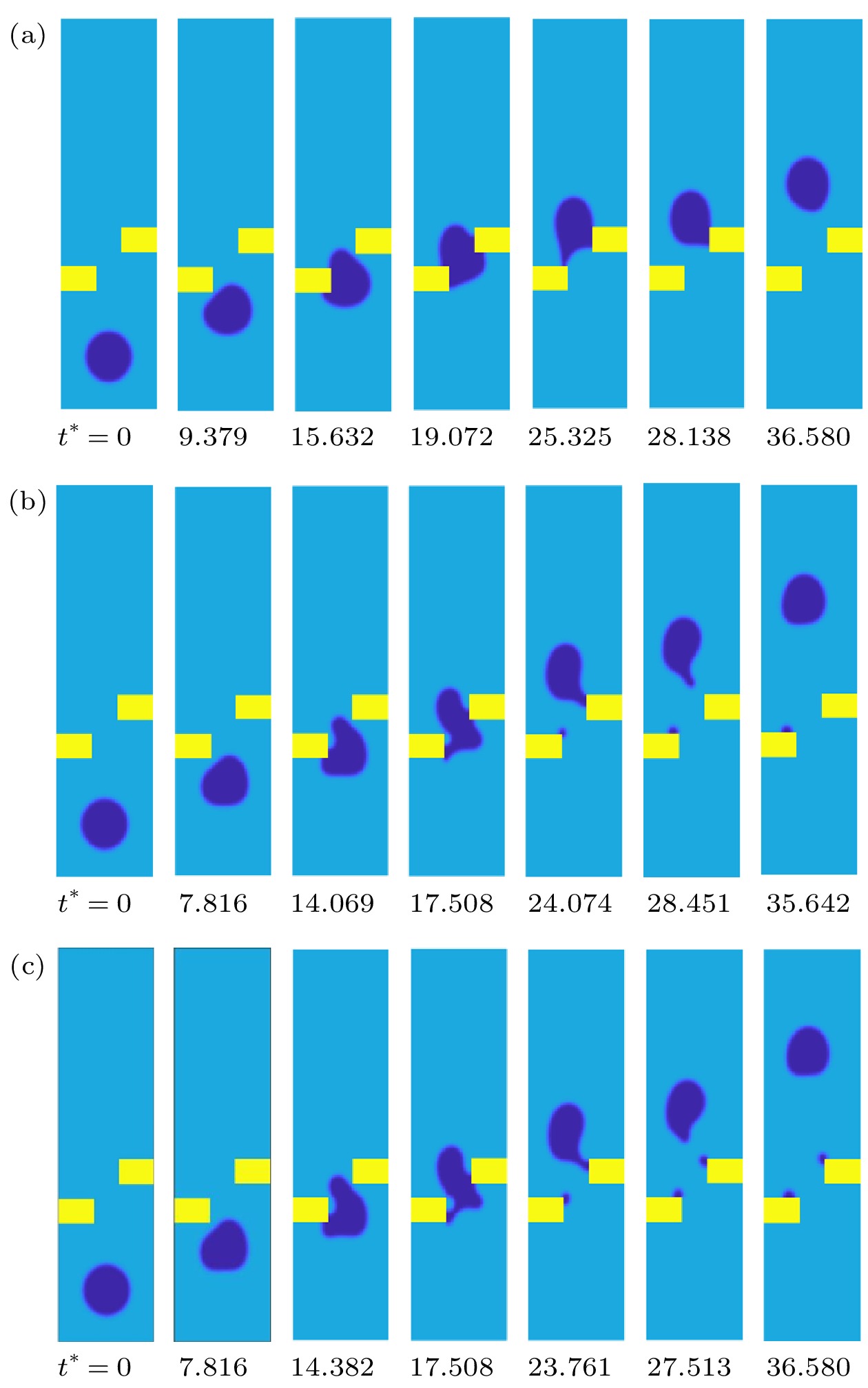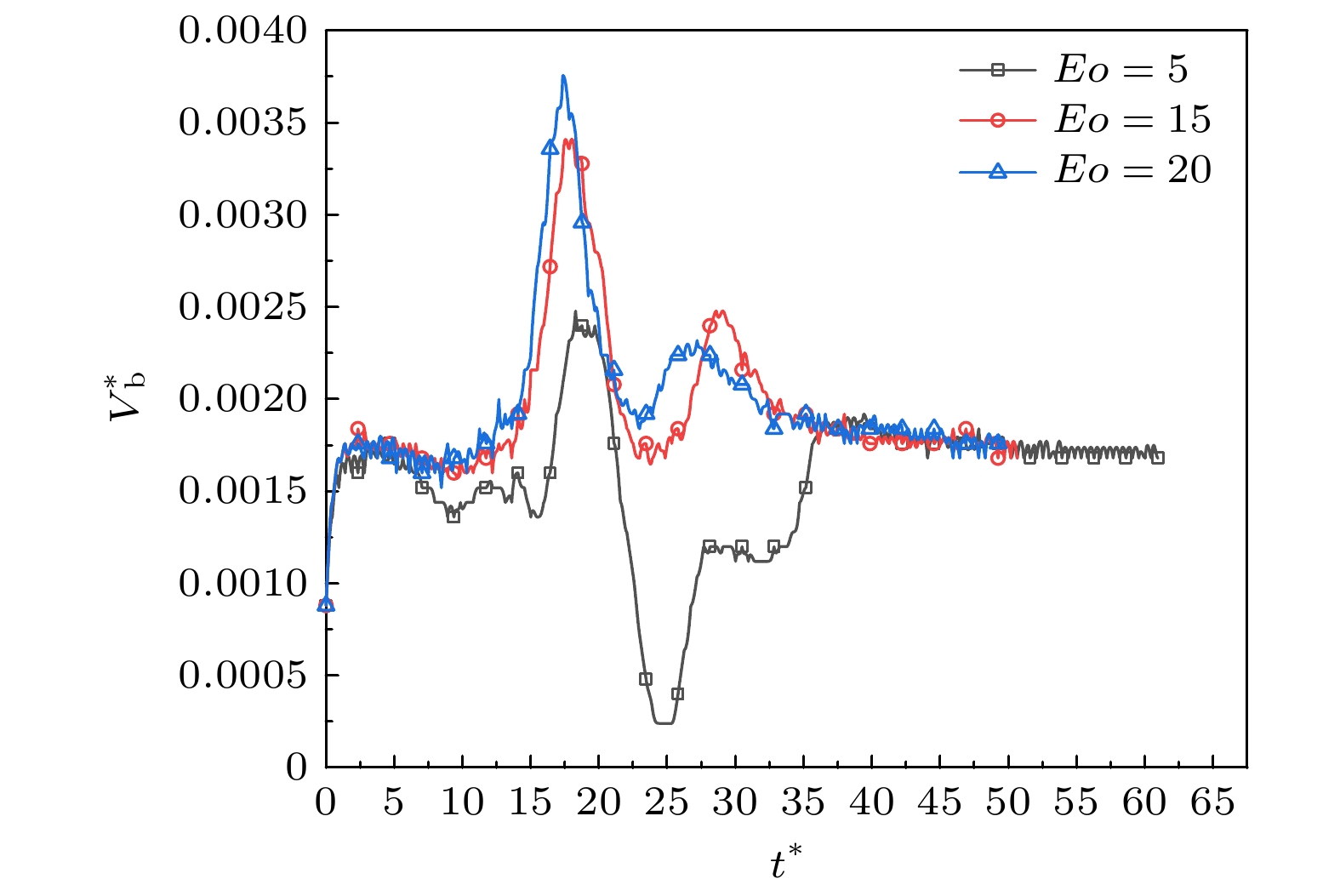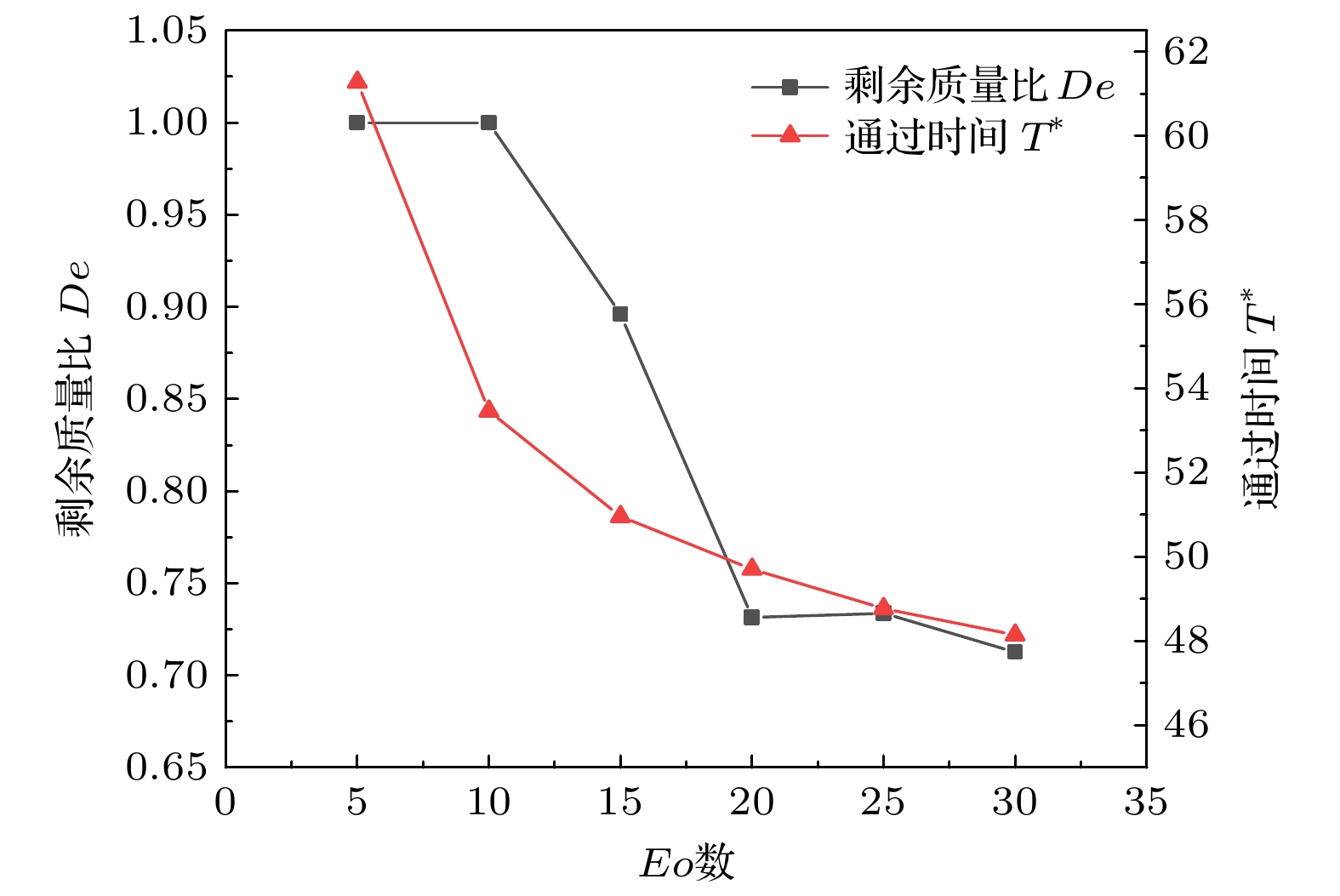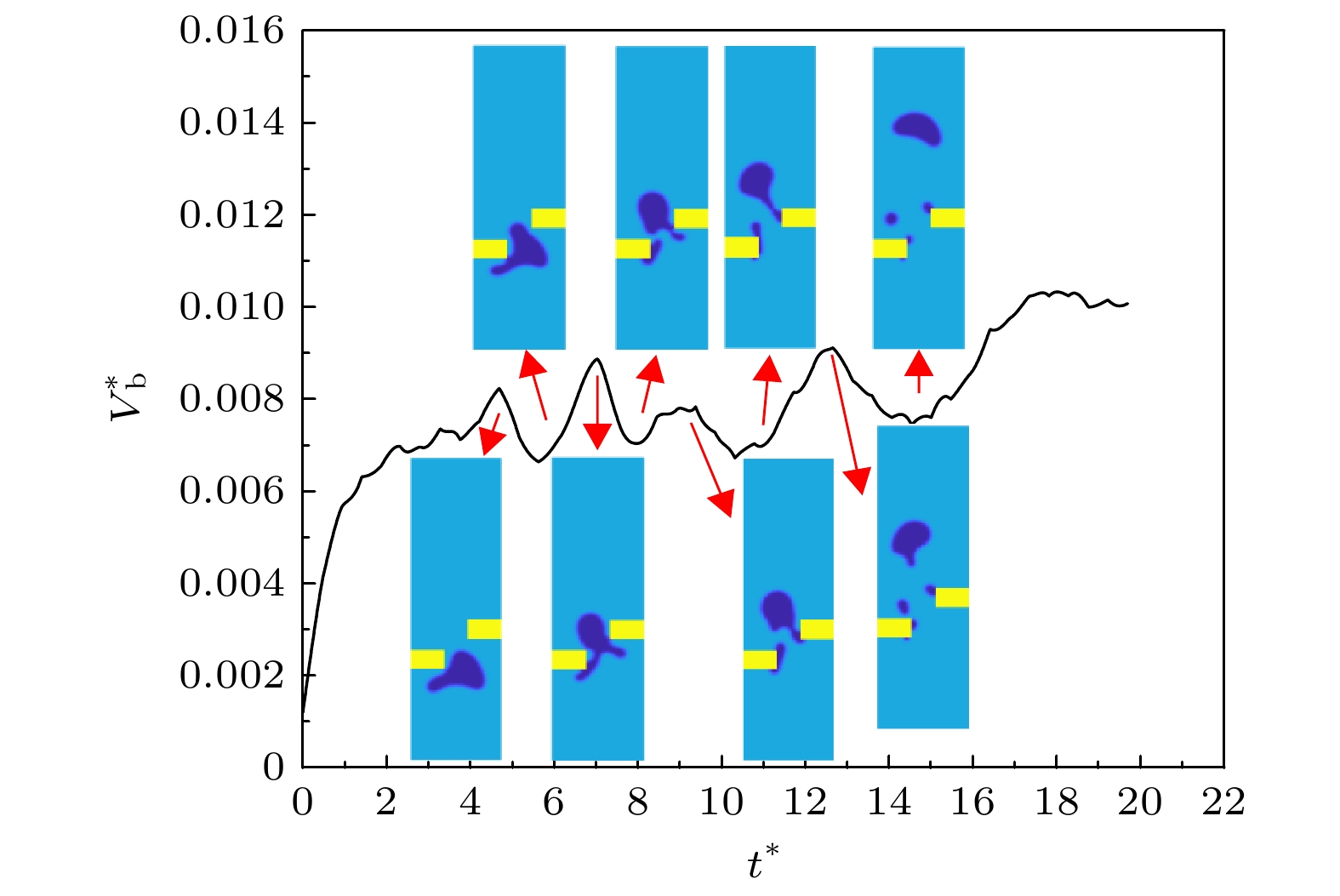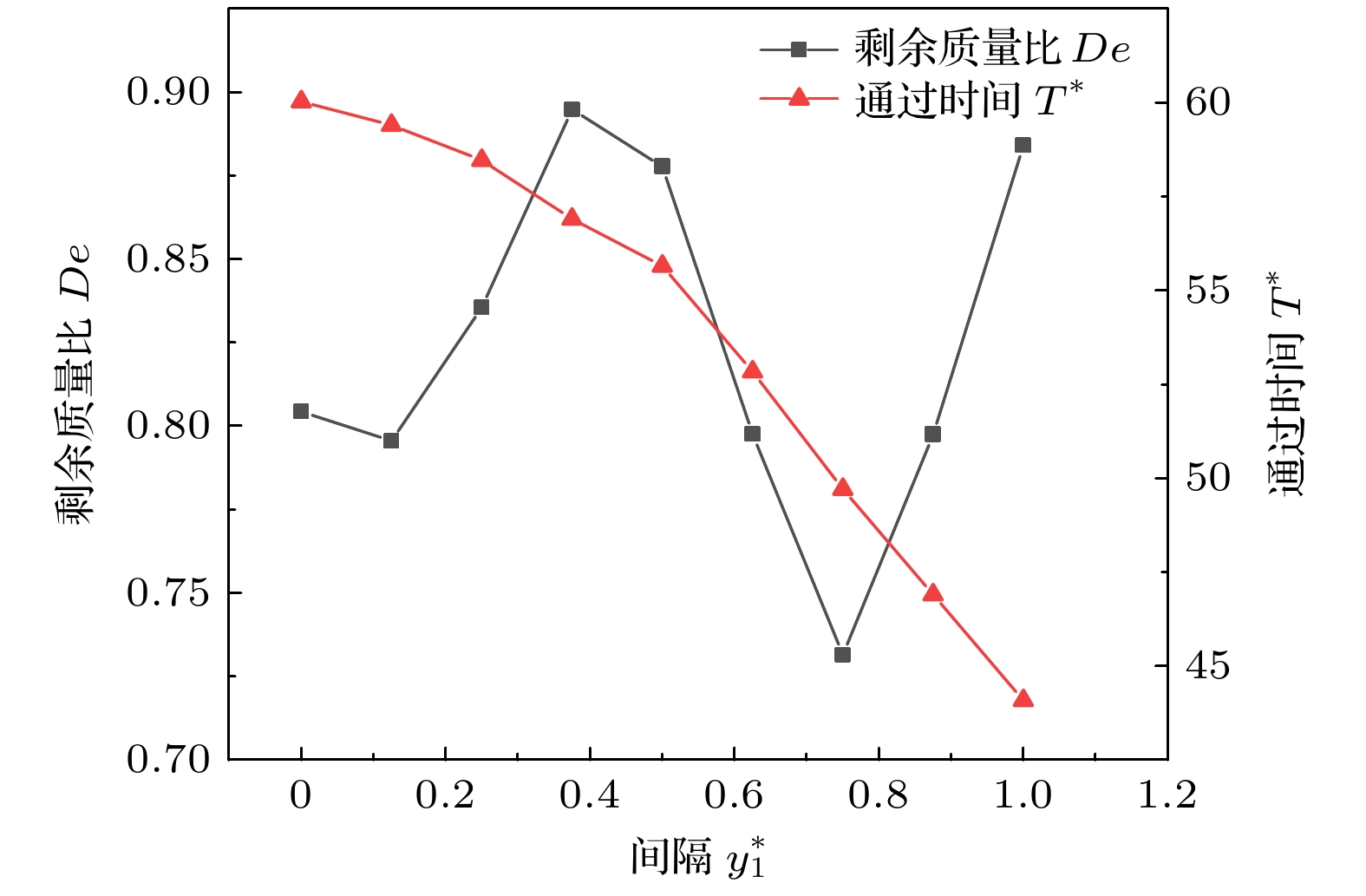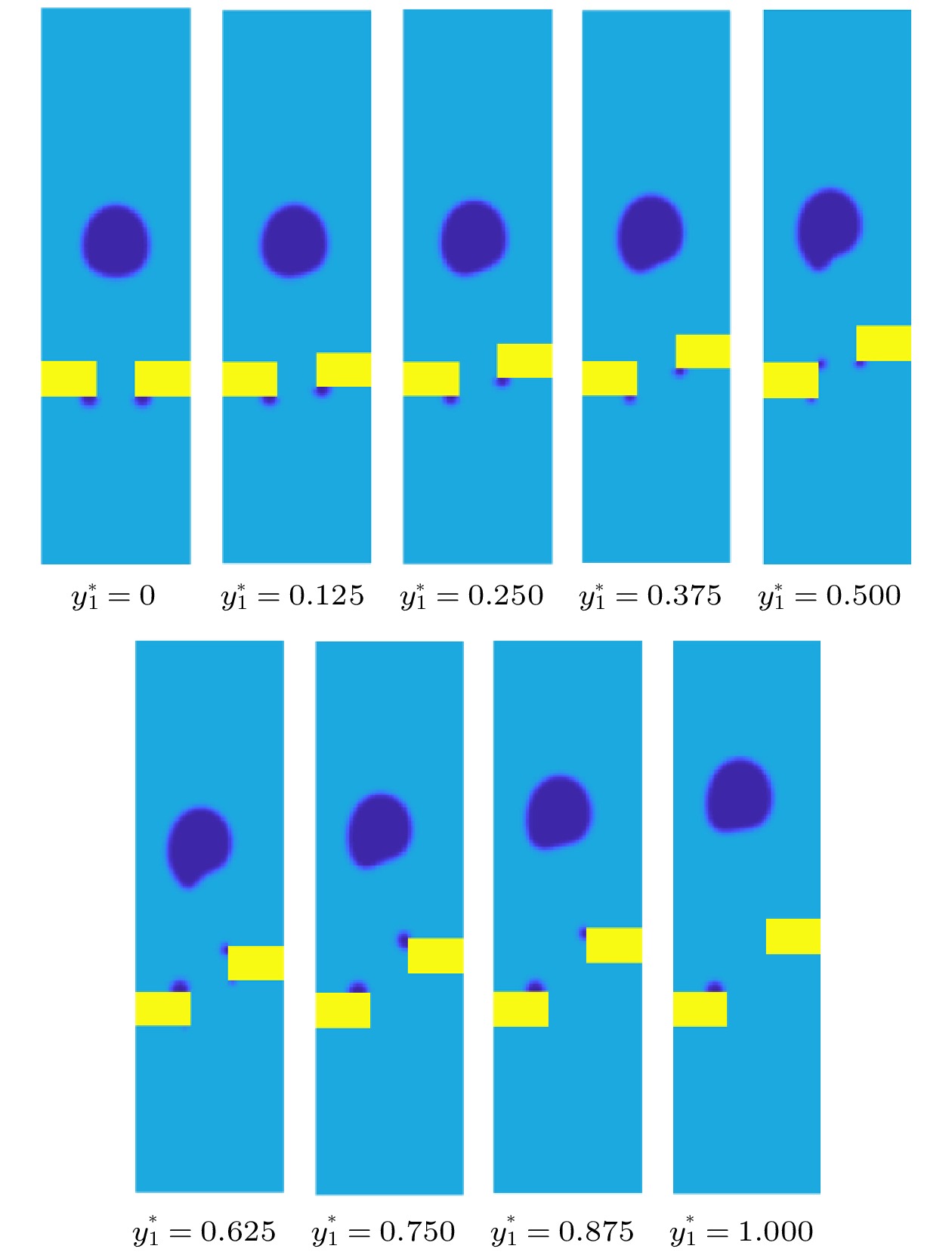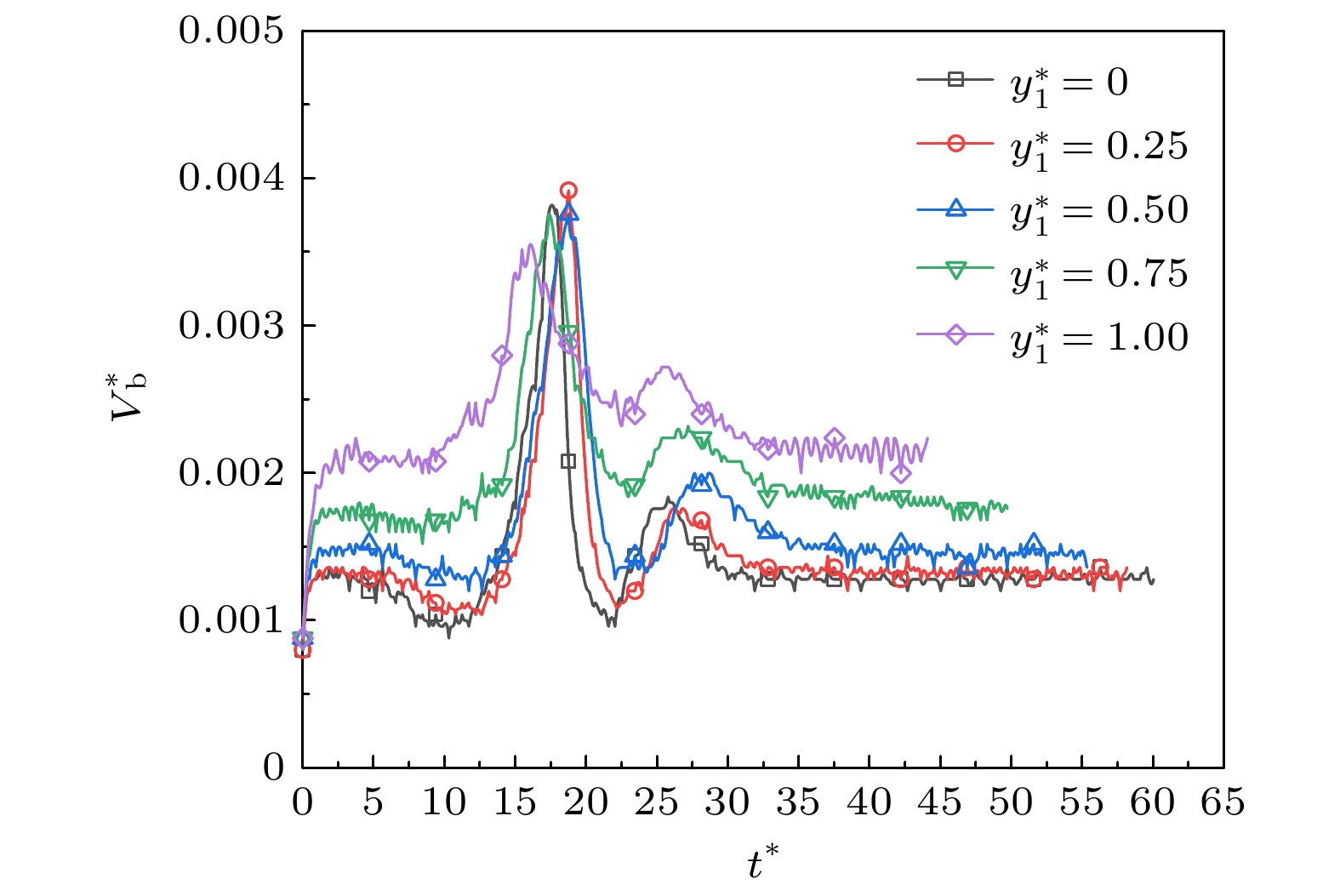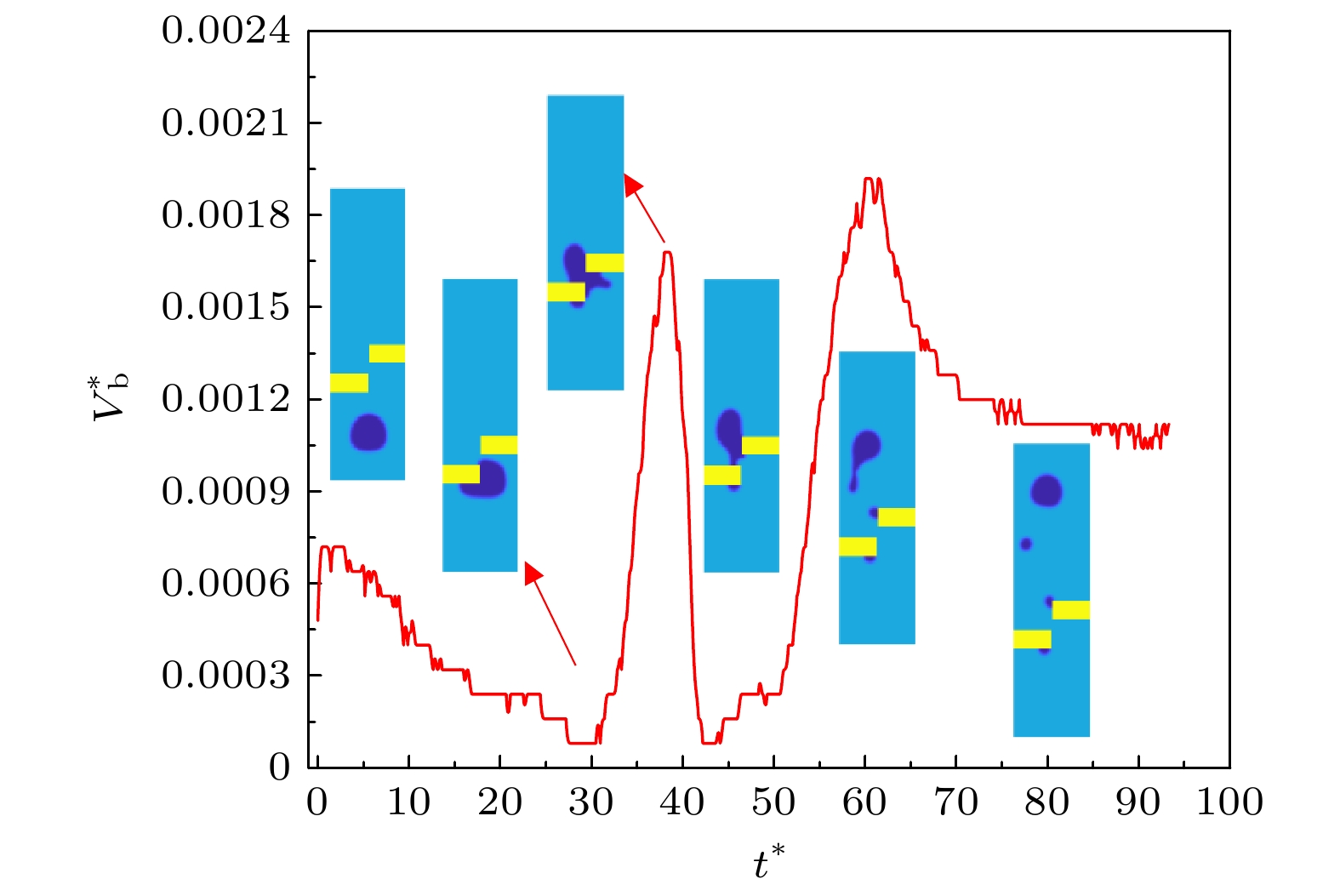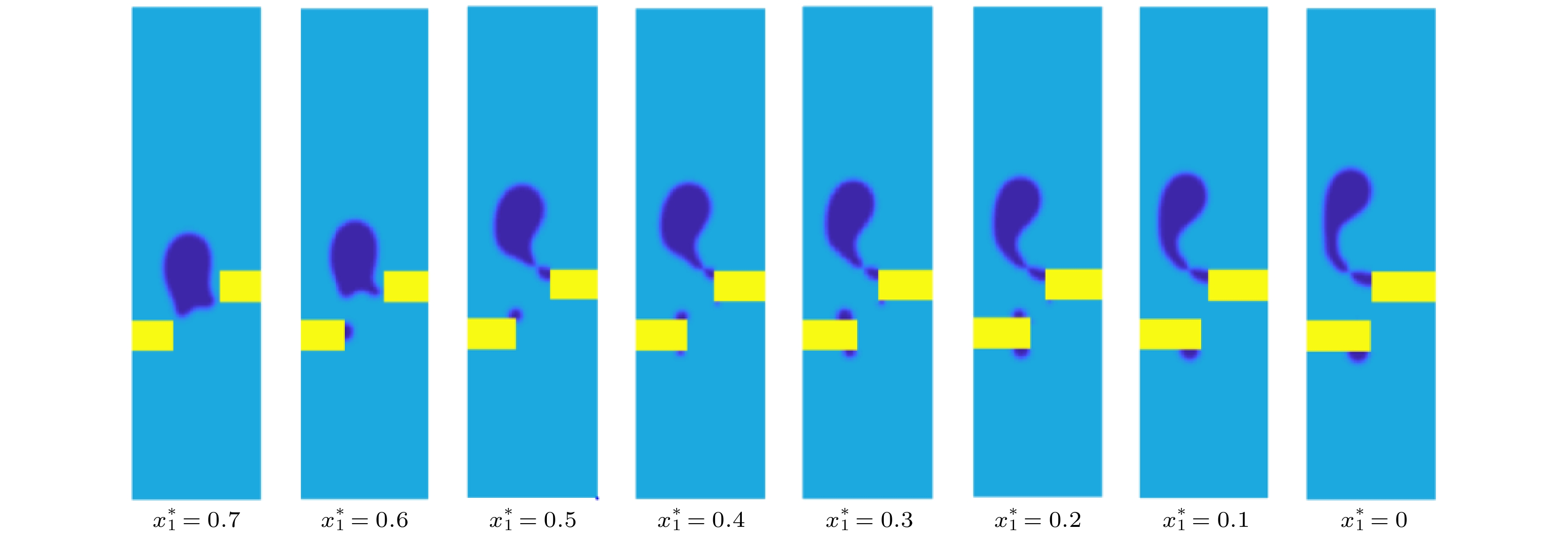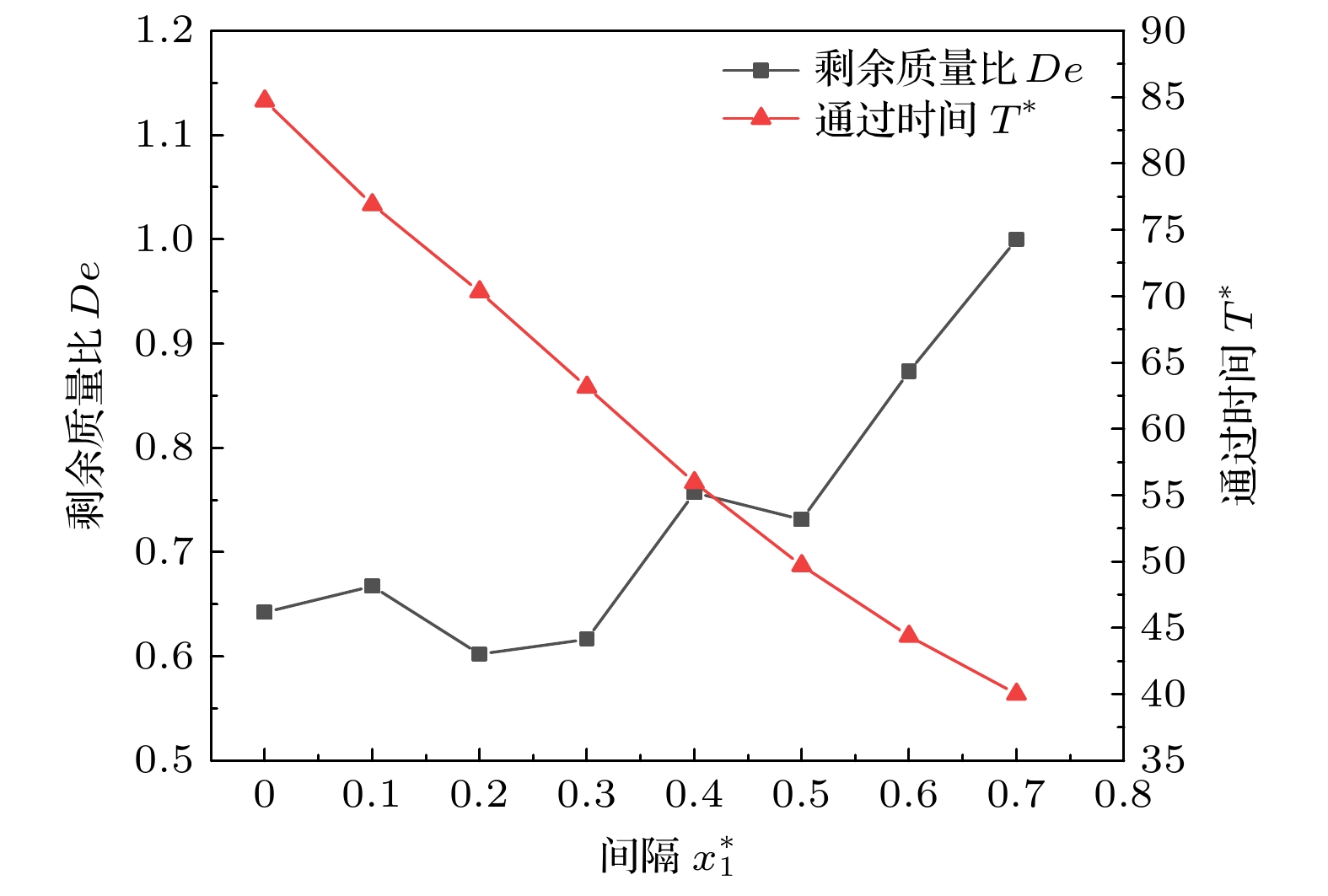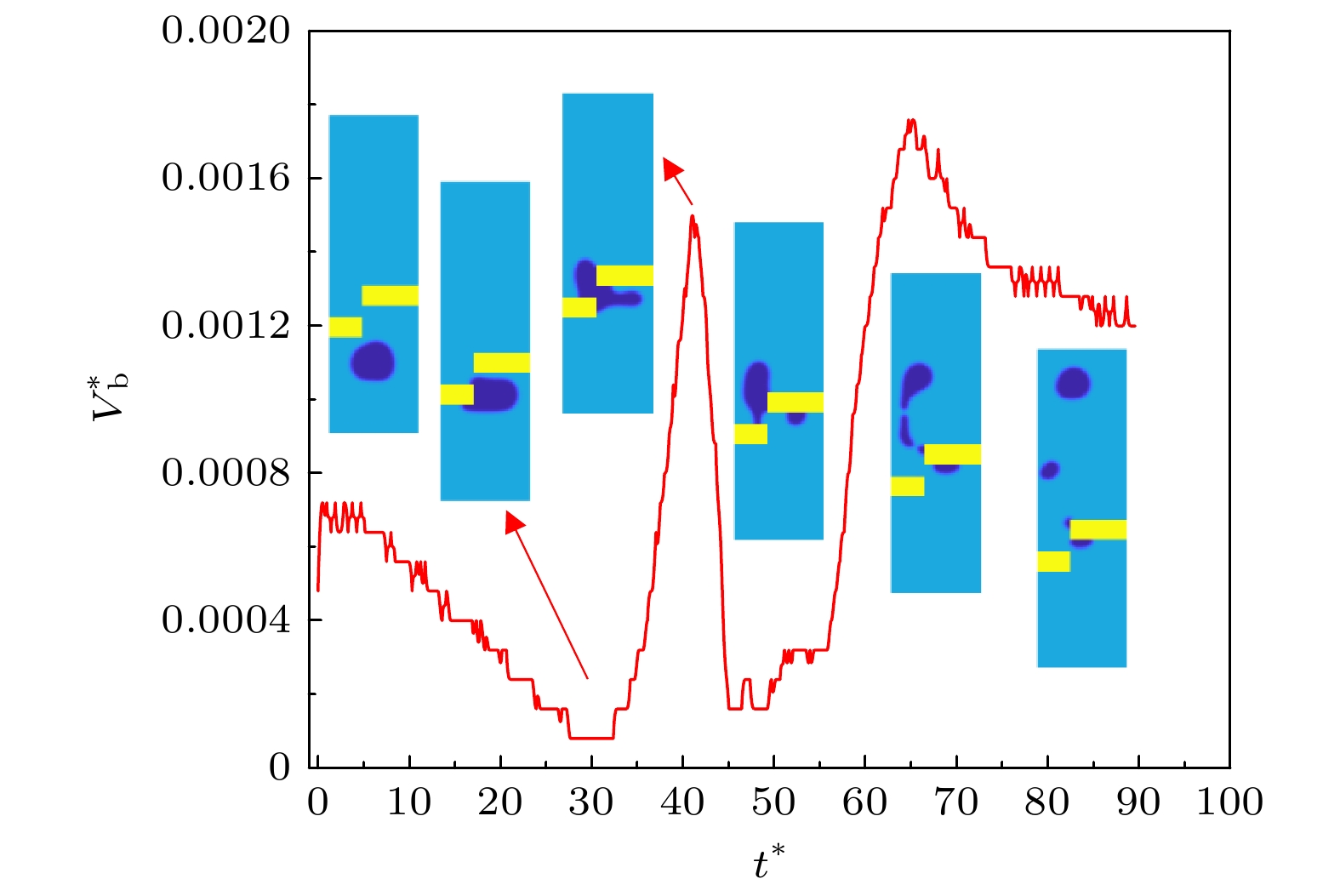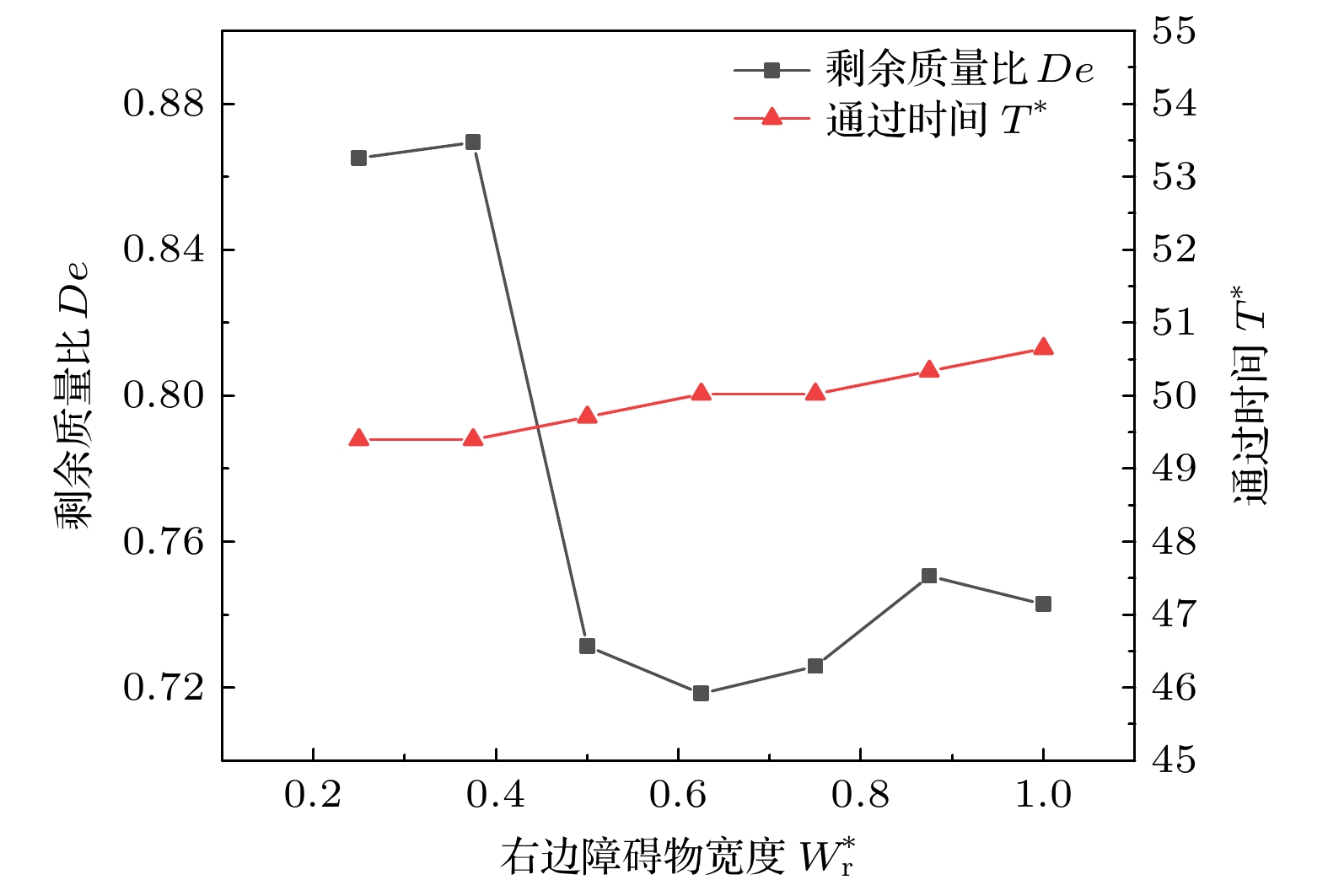-
采用格子玻尔兹曼方法研究了含非对称障碍物微通道内气泡变形、分裂、上升速度、以及剩余质量比的变化规律. 研究结果表明, 首先, 气泡在穿过通道的过程中变形加剧时其上升速度会减小. 其次, 随着Eötvös数增加, 气泡在穿过障碍物的过程中形变越来越严重, 速度越来越大且通过时间越来越小. 除此之外, 随着气液黏度比增加, 气泡变形更严重, 上升速度显著增加, 且气泡剩余质量比减少. 另一方面, 随着障碍物纵向距离增加, 气泡通过障碍物的时间减少, 而气泡的剩余质量比呈现近似不变-增加-减小-增加的变化趋势. 再者, 为了研究障碍物横向距离对气泡运动形态的影响, 考虑了两种情况: 一是两障碍物长度同时改变; 二是仅改变单侧障碍物长度. 结果表明, 对于以上两种情况, 当横向距离较小时, 仅改变单侧障碍物长度造成气泡通过障碍物的时间更长. 最后, 研究结果还表明当右侧障碍物宽度足够大时, 气泡离开障碍物时的位置几乎不变, 而随着右侧障碍物宽度的增加, 气泡穿过障碍物的时间缓慢增加, 气泡的剩余质量比先近似不变然后大幅下降最后又保持近似不变.Bubbles are existent everywhere and of great importance for the daily life and industry process, such as heat exchange rate influenced by bubbles in the tube, battery life partially decided by bubbles of chemical reaction in it, etc. With the further requirement for miniaturization, physical mechanisms behind bubble behaviors in microchannels become crucial. In the present work, the lattice Boltzmann method is used to investigate the behavior of bubbles as they rise in complex microchannels under the action of buoyancy. The channel is placed with two asymmetric obstacles on its left and right side. Initially, the lattice Boltzmann model is tested for its reliability and accuracy by Laplace law. Then a few parameters of flow field, i.e. the Eötvös number, the viscosity ratio, the vertical distance between the obstacles, the horizontal distance between the obstacles, are employed to study the characteristics of the bubble during the movement, including the deformation, the rising speed, the residual mass, and the time of bubble passing through the channel. The results are shown below. First, the trend of the bubble's velocity changing with time in the process of passing through the channel corresponds to the change process of the dynamic behavior of the interface, i.e. the bubble velocity decreases when the bubble shape changes significantly under the same channel width. Second, with the increase of
$ Eo $ number, the bubble deformation as well as the bubble velocity increases and the bubble residual mass decreases. Besides, the gas-to-liquid viscosity ratio has a significant effect on the bubble velocity. Under the condition of high viscosity ratio, the bubble shape is difficult to maintain a round shape, while the bubble rise velocity increases and the residual mass of the bubble decreases with the viscosity ratio. What is more, when the obstacle setting is changed, the longer the vertical distance between the two asymmetric obstacles, the shorter the bubble passing time is, and the faster it will return to the original shape after passing through the obstacle, while the residual mass of the bubble shows a change trend of approximately unchanged-increase-decrease-increase with the augment of the vertical distance between the obstacles. In the study of changing the horizontal spacing, two cases: the two obstacles are changed at the same time (Case A) and only the one-sided obstacle is changed (Case B), are considered. The results show that under the same small horizontal interval, the obstruction effect caused by changing only the length of one side obstacle is stronger. Finally, the study shows that when the width of the right obstacle is long enough, although the width of the obstacle continues to increase, the passing time of the bubble increases slowly, and the position of the bubble leaving from the obstacle is always approximately the same.-
Keywords:
- asymmetric obstacles /
- bubble rise /
- gas-liquid two-phase flow /
- large density ratio
[1] 张文彬, 廖龙光, 于同旭, 纪爱玲 2013 物理学报 62 196102
 Google Scholar
Google Scholar
Zhang W B, Liao L G, Yu T X, Ji A L 2013 Acta Phys. Sin. 62 196102
 Google Scholar
Google Scholar
[2] 王勇, 林书玉, 莫润阳, 张小丽 2013 物理学报 62 134304
 Google Scholar
Google Scholar
Wang Y, Lin S Y, Mo R Y, Zhang X L 2013 Acta Phys. Sin. 62 134304
 Google Scholar
Google Scholar
[3] Su C J, Chou J M, Liu S H, Chiang C H 2010 Mater. Trans. 51 1594
 Google Scholar
Google Scholar
[4] 李涛, 魏列江, 张吉智, 梁汝健, 张振华 2021 液压与气动 45 49
 Google Scholar
Google Scholar
Li T, Wei L J, Zhang J Z, Liang R J, Zhang Z H 2021 Chin. Hydrau. Pneumatics 45 49
 Google Scholar
Google Scholar
[5] 沈兰亭, 柴翔, 程旭 2020 核动力工程 41 194
 Google Scholar
Google Scholar
Shen L T, Chai X, Cheng X 2020 Nuclear Power Engineering 41 194
 Google Scholar
Google Scholar
[6] 朱前林, 李小春, 魏宁, 胡海翔 2012 岩土力学 33 913
 Google Scholar
Google Scholar
Zhu Q L, Li X C, Wei N, Hu H X 2012 Rock and Soil Mechanics 33 913
 Google Scholar
Google Scholar
[7] 陈福振, 强洪夫, 高巍然 2014 物理学报 63 230206
 Google Scholar
Google Scholar
Chen F Z, Qiang H F, Gao W R 2014 Acta Phys. Sin. 63 230206
 Google Scholar
Google Scholar
[8] 容亮湾, 詹杰民 2010 物理学报 59 5572
 Google Scholar
Google Scholar
Rong L W, Zhan J M 2010 Acta Phys. Sin. 59 5572
 Google Scholar
Google Scholar
[9] 何健烽, 章渊昶, 朱菊香, 姚克俭 2010 化工进展 29 831
 Google Scholar
Google Scholar
He J F, Zhang Y C, Zhu J X, Yao K J 2010 Chem. Ind. Eng. Prog. 29 831
 Google Scholar
Google Scholar
[10] 王波, 沈诗怡, 阮琰炜, 程淑影, 彭望君, 张捷宇 2020 金属学报 56 619
 Google Scholar
Google Scholar
Wang B, Shen S Y, Ruan Y W, Chen S Y, Peng W J, Zhang J Y 2020 Acta Metall. Sin. 56 619
 Google Scholar
Google Scholar
[11] Wang Z, Yu Y 2015 Energy 89 259
 Google Scholar
Google Scholar
[12] Davies R M, Taylor G 1950 Proc. R. Soc. London, Ser. A 200 375
 Google Scholar
Google Scholar
[13] Walters J K, Davidson J F 1963 J. Fluid Mech. 17 321
[14] Unverdi S O, Tryggvason G 1992 J. Comput. Phys. 100 25
 Google Scholar
Google Scholar
[15] 艾旭鹏, 倪宝玉 2017 物理学报 66 234702
 Google Scholar
Google Scholar
Ai X P, Ni B Y 2017 Acta Phys. Sin. 66 234702
 Google Scholar
Google Scholar
[16] Rabha S S, Buwa V V 2010 Chem. Eng. Sci. 65 527
 Google Scholar
Google Scholar
[17] Moran H R, Magnini M, Markides C N, Matar O K 2021 Int. J. Multiphase Flow 135 103468
 Google Scholar
Google Scholar
[18] Chakraborty I, Biswas G, Ghoshdastidar P S 2013 Int. J. Heat Mass Transfer 58 240
 Google Scholar
Google Scholar
[19] Anwar S 2013 Comput. Fluids 88 430
 Google Scholar
Google Scholar
[20] Alizadeh M, Seyyedi S M, Rahni M T, Ganji D D 2017 J. Mol. Liq. 236 151
 Google Scholar
Google Scholar
[21] 娄钦, 李涛, 杨茉 2018 物理学报 67 234701
 Google Scholar
Google Scholar
Lou Q, Li T, Yang M 2018 Acta Phys. Sin. 67 234701
 Google Scholar
Google Scholar
[22] Lou Q, Li T, Yang M 2019 J. Appl. Phys. 126 034301
 Google Scholar
Google Scholar
[23] Yi J, Xing H 2017 Chem. Eng. Sci. 161 57
 Google Scholar
Google Scholar
[24] Sattari E, Zanous S P, Farhadi M, Mohamad A 2020 J. Power Sources 454 227929
 Google Scholar
Google Scholar
[25] Yu K, Yong Y, Yang C 2020 Processes 8 1608
 Google Scholar
Google Scholar
[26] Liang H, Xu J, Chen J, Wang H, Shi B 2018 Phys. Rev. E 97 033309
 Google Scholar
Google Scholar
[27] Zhu C S, Ma F L, Lei P, Han D, Feng L 2021 Chin. J. Phys. 71 385
 Google Scholar
Google Scholar
[28] Sun Y, Beckermann C 2007 J. Comput. Phys. 220 626
 Google Scholar
Google Scholar
[29] Chiu P H, Lin Y T 2011 J. Comput. Phys. 230 185
 Google Scholar
Google Scholar
[30] Guo Z L, Zheng C G, Shi B C 2002 Phys. Rev. E 65 046308
 Google Scholar
Google Scholar
[31] Wei Y, Wang Z, Yang J, Dou H S, Qian Y 2015 Comput. Fluids 118 167
 Google Scholar
Google Scholar
[32] Ren F, Song B, Sukop M C, Hu H 2016 Phys. Rev. E 94 023311
 Google Scholar
Google Scholar
[33] Guo Z, Zheng C, Shi B 2011 Phys. Rev. E 83 036707
 Google Scholar
Google Scholar
[34] 陈海楠, 孙东科, 戴挺, 朱鸣芳 2013 物理学报 62 120502
 Google Scholar
Google Scholar
Chen H N, Sun D K, Dai T, Zhu M F 2013 Acta Phys. Sin. 62 120502
 Google Scholar
Google Scholar
[35] Ladd A J C 1994 J. Fluid Mech. 271 285
 Google Scholar
Google Scholar
[36] Ladd A J C 1994 J. Fluid Mech. 271 311
 Google Scholar
Google Scholar
[37] Yuan P, Schaefer L 2006 Phys. Fluids 18 042101
 Google Scholar
Google Scholar
[38] Chen S, Wang Z, Shan X, Goolen G D 1992 J. Stat. Phys. 68 379
 Google Scholar
Google Scholar
[39] Ohta M, Sussman M 2012 Phys. Fluids 24 112101
 Google Scholar
Google Scholar
[40] Hua J, Lou J 2007 J. Comput. Phys. 222 769
 Google Scholar
Google Scholar
[41] Amaya-Bower L, Lee T 2010 Comput. Fluids 39 1191
 Google Scholar
Google Scholar
-
-
[1] 张文彬, 廖龙光, 于同旭, 纪爱玲 2013 物理学报 62 196102
 Google Scholar
Google Scholar
Zhang W B, Liao L G, Yu T X, Ji A L 2013 Acta Phys. Sin. 62 196102
 Google Scholar
Google Scholar
[2] 王勇, 林书玉, 莫润阳, 张小丽 2013 物理学报 62 134304
 Google Scholar
Google Scholar
Wang Y, Lin S Y, Mo R Y, Zhang X L 2013 Acta Phys. Sin. 62 134304
 Google Scholar
Google Scholar
[3] Su C J, Chou J M, Liu S H, Chiang C H 2010 Mater. Trans. 51 1594
 Google Scholar
Google Scholar
[4] 李涛, 魏列江, 张吉智, 梁汝健, 张振华 2021 液压与气动 45 49
 Google Scholar
Google Scholar
Li T, Wei L J, Zhang J Z, Liang R J, Zhang Z H 2021 Chin. Hydrau. Pneumatics 45 49
 Google Scholar
Google Scholar
[5] 沈兰亭, 柴翔, 程旭 2020 核动力工程 41 194
 Google Scholar
Google Scholar
Shen L T, Chai X, Cheng X 2020 Nuclear Power Engineering 41 194
 Google Scholar
Google Scholar
[6] 朱前林, 李小春, 魏宁, 胡海翔 2012 岩土力学 33 913
 Google Scholar
Google Scholar
Zhu Q L, Li X C, Wei N, Hu H X 2012 Rock and Soil Mechanics 33 913
 Google Scholar
Google Scholar
[7] 陈福振, 强洪夫, 高巍然 2014 物理学报 63 230206
 Google Scholar
Google Scholar
Chen F Z, Qiang H F, Gao W R 2014 Acta Phys. Sin. 63 230206
 Google Scholar
Google Scholar
[8] 容亮湾, 詹杰民 2010 物理学报 59 5572
 Google Scholar
Google Scholar
Rong L W, Zhan J M 2010 Acta Phys. Sin. 59 5572
 Google Scholar
Google Scholar
[9] 何健烽, 章渊昶, 朱菊香, 姚克俭 2010 化工进展 29 831
 Google Scholar
Google Scholar
He J F, Zhang Y C, Zhu J X, Yao K J 2010 Chem. Ind. Eng. Prog. 29 831
 Google Scholar
Google Scholar
[10] 王波, 沈诗怡, 阮琰炜, 程淑影, 彭望君, 张捷宇 2020 金属学报 56 619
 Google Scholar
Google Scholar
Wang B, Shen S Y, Ruan Y W, Chen S Y, Peng W J, Zhang J Y 2020 Acta Metall. Sin. 56 619
 Google Scholar
Google Scholar
[11] Wang Z, Yu Y 2015 Energy 89 259
 Google Scholar
Google Scholar
[12] Davies R M, Taylor G 1950 Proc. R. Soc. London, Ser. A 200 375
 Google Scholar
Google Scholar
[13] Walters J K, Davidson J F 1963 J. Fluid Mech. 17 321
[14] Unverdi S O, Tryggvason G 1992 J. Comput. Phys. 100 25
 Google Scholar
Google Scholar
[15] 艾旭鹏, 倪宝玉 2017 物理学报 66 234702
 Google Scholar
Google Scholar
Ai X P, Ni B Y 2017 Acta Phys. Sin. 66 234702
 Google Scholar
Google Scholar
[16] Rabha S S, Buwa V V 2010 Chem. Eng. Sci. 65 527
 Google Scholar
Google Scholar
[17] Moran H R, Magnini M, Markides C N, Matar O K 2021 Int. J. Multiphase Flow 135 103468
 Google Scholar
Google Scholar
[18] Chakraborty I, Biswas G, Ghoshdastidar P S 2013 Int. J. Heat Mass Transfer 58 240
 Google Scholar
Google Scholar
[19] Anwar S 2013 Comput. Fluids 88 430
 Google Scholar
Google Scholar
[20] Alizadeh M, Seyyedi S M, Rahni M T, Ganji D D 2017 J. Mol. Liq. 236 151
 Google Scholar
Google Scholar
[21] 娄钦, 李涛, 杨茉 2018 物理学报 67 234701
 Google Scholar
Google Scholar
Lou Q, Li T, Yang M 2018 Acta Phys. Sin. 67 234701
 Google Scholar
Google Scholar
[22] Lou Q, Li T, Yang M 2019 J. Appl. Phys. 126 034301
 Google Scholar
Google Scholar
[23] Yi J, Xing H 2017 Chem. Eng. Sci. 161 57
 Google Scholar
Google Scholar
[24] Sattari E, Zanous S P, Farhadi M, Mohamad A 2020 J. Power Sources 454 227929
 Google Scholar
Google Scholar
[25] Yu K, Yong Y, Yang C 2020 Processes 8 1608
 Google Scholar
Google Scholar
[26] Liang H, Xu J, Chen J, Wang H, Shi B 2018 Phys. Rev. E 97 033309
 Google Scholar
Google Scholar
[27] Zhu C S, Ma F L, Lei P, Han D, Feng L 2021 Chin. J. Phys. 71 385
 Google Scholar
Google Scholar
[28] Sun Y, Beckermann C 2007 J. Comput. Phys. 220 626
 Google Scholar
Google Scholar
[29] Chiu P H, Lin Y T 2011 J. Comput. Phys. 230 185
 Google Scholar
Google Scholar
[30] Guo Z L, Zheng C G, Shi B C 2002 Phys. Rev. E 65 046308
 Google Scholar
Google Scholar
[31] Wei Y, Wang Z, Yang J, Dou H S, Qian Y 2015 Comput. Fluids 118 167
 Google Scholar
Google Scholar
[32] Ren F, Song B, Sukop M C, Hu H 2016 Phys. Rev. E 94 023311
 Google Scholar
Google Scholar
[33] Guo Z, Zheng C, Shi B 2011 Phys. Rev. E 83 036707
 Google Scholar
Google Scholar
[34] 陈海楠, 孙东科, 戴挺, 朱鸣芳 2013 物理学报 62 120502
 Google Scholar
Google Scholar
Chen H N, Sun D K, Dai T, Zhu M F 2013 Acta Phys. Sin. 62 120502
 Google Scholar
Google Scholar
[35] Ladd A J C 1994 J. Fluid Mech. 271 285
 Google Scholar
Google Scholar
[36] Ladd A J C 1994 J. Fluid Mech. 271 311
 Google Scholar
Google Scholar
[37] Yuan P, Schaefer L 2006 Phys. Fluids 18 042101
 Google Scholar
Google Scholar
[38] Chen S, Wang Z, Shan X, Goolen G D 1992 J. Stat. Phys. 68 379
 Google Scholar
Google Scholar
[39] Ohta M, Sussman M 2012 Phys. Fluids 24 112101
 Google Scholar
Google Scholar
[40] Hua J, Lou J 2007 J. Comput. Phys. 222 769
 Google Scholar
Google Scholar
[41] Amaya-Bower L, Lee T 2010 Comput. Fluids 39 1191
 Google Scholar
Google Scholar
计量
- 文章访问数: 6725
- PDF下载量: 92
- 被引次数: 0














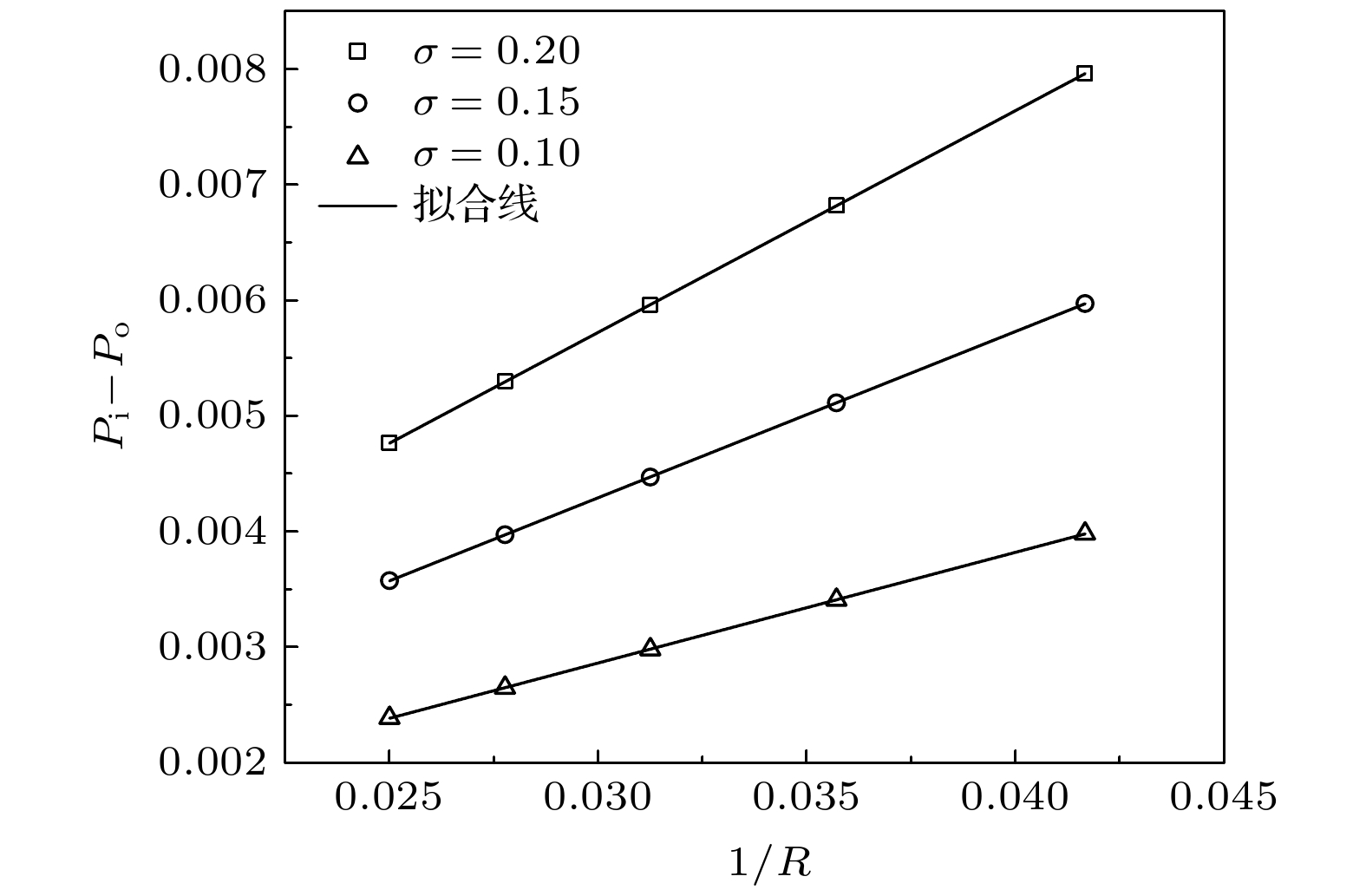
 下载:
下载:
